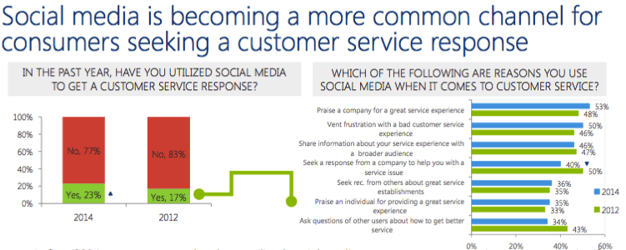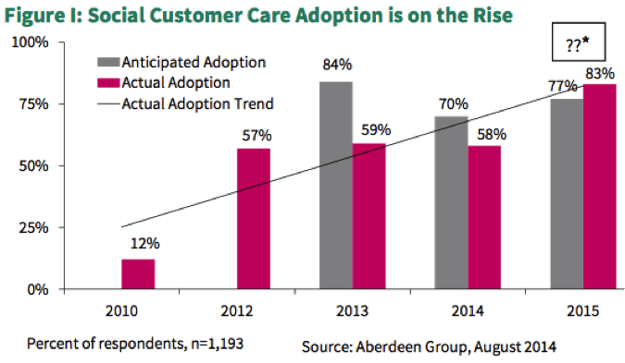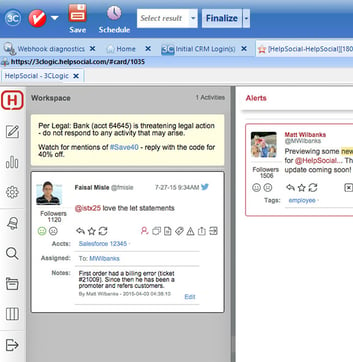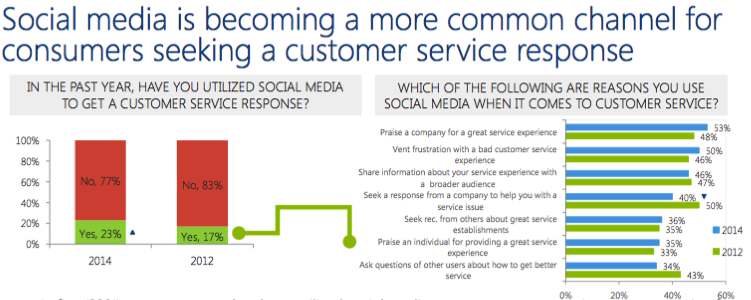As the Internet and mobile devices become faster and more efficient, the number of communication channels available to consumers seeking customer support continues to rapidly expand. What was once a purely telephony-based task has since expanded to alternative channels, including email, text, chat, video—and increasingly, social media. In fact, nearly one in three social media users prefers to reach out to a brand for customer service through a social channel compared to the phone. And by 2020, it is estimated that an astounding 90% of customer service inquiries will be handled through social channels. Touted for its convenience, speed, and ease-of-use, this relatively new channel appears to paving the way for the future of customer service.
 As a result, businesses are increasingly looking to adopt “social customer care” strategies in order to adequately meet the needs of their social consumers. Consider the following: in 2010, only 12% of Aberdeen surveyed companies had adopted a “Social Customer Care” strategy (whatever that meant at the time). Fast-forward to 2015, and 85% of surveyed businesses have adopted a “social customer care” strategy, a number that is expected to continue growing.
As a result, businesses are increasingly looking to adopt “social customer care” strategies in order to adequately meet the needs of their social consumers. Consider the following: in 2010, only 12% of Aberdeen surveyed companies had adopted a “Social Customer Care” strategy (whatever that meant at the time). Fast-forward to 2015, and 85% of surveyed businesses have adopted a “social customer care” strategy, a number that is expected to continue growing.

But while these tech-saavy, mobile consumers increasingly hope to resolve their needs through this fast and easy channel, businesses continue to wrestle with the large volume of service requests flooding their profiles. As a matter of fact, 56% of customer service related tweets go ignored by companies. But failure to respond via social channels can lead to a 15% increase in churn rate for existing customers—not to mention, a PR nightmare. So while adoption of “social customer care” strategies seems to be on the rise, and businesses understand the importance of offering social media as a service channel, why the disconnect? And how do you resolve it?

3 Steps to Successfully Managing Social Media as a Customer Service Channel:
Don’t let marketing handle service requests via social media: According to DMG, over 41% of companies assign all social media tasks to their marketers, despite the fact a large bulk of comments and feedback are customer service and support related. While yes, marketers are well suited to promoting products, creating brand recognition, sending alerts, and even responding to customer comments on social media, they are typically not as well-informed regarding product, service, and customer specific needs. Therefore the case can be made, they should not attempt to resolve them. Instead, businesses should adopt a social media management platform designed for customer service that can automatically route urgent customer posts into a contact center agent’s queue, allowing those who are better equipped to resolve client problems, while ensuring no posts are accidently ignored. And it pays! Companies considered “best-in-class” as it relates to social customer care are nearly three times as likely to have a dedicated strategy for social media that stretches across all customer engagement channels such as service, sales, and marketing.
Link social media to your system of record: Adopting a social customer care strategy is of little value if employees are unable to quickly identify who the consumer making the post is, and what their relationship with the organization might otherwise be—Are they a current customer? Have they purchased from you in the past? Are they one of your most valued clients?—certainly important details. By linking social media accounts to contacts hosted within the system of record, company representatives can automatically understand who the individual making the post is, what their relationship to organization might be (if any), and what prior interactions the company has had with them to allow the proper measures to be taken. “Best-in-class” organizations who excel in social customer service performance are 33% more likely to provide their agents with past social interaction history and 340% more likely to view past customer service history across all channels.

Manage social media in conjunction with other channels: While offering social media as a customer service channel is certainly a necessity, there are many instances where social media alone simply will not suffice. In fact, service issues which tend to be more complex often need to be escalated to another channel (phone, email, chat, etc.). But by integrating social media into an advanced contact center solution with multichannel communications, representatives can easily route posts to the agent queue and communicate with customers through any desired channel. Those businesses considered to be “leading social performers” are more likely to provide social agents with the ability to escalate social discussions to another channel, and create service tickets without further action from customers.





